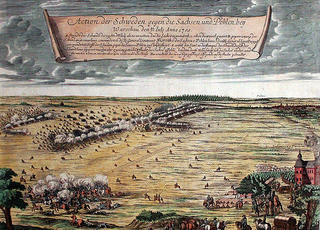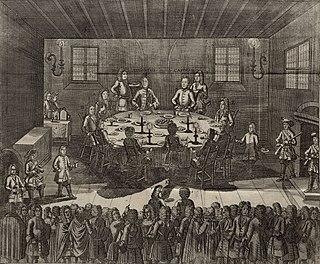
The Great Northern War (1700–1721) was a conflict in which a coalition led by the Tsardom of Russia successfully contested the supremacy of the Swedish Empire in Northern, Central and Eastern Europe. The initial leaders of the anti-Swedish alliance were Peter I of Russia, Frederick IV of Denmark–Norway and Augustus II the Strong of Saxony–Poland–Lithuania. Frederick IV and Augustus II were defeated by Sweden, under Charles XII, and forced out of the alliance in 1700 and 1706 respectively, but rejoined it in 1709 after the defeat of Charles XII at the Battle of Poltava. George I of Great Britain and the Electorate of Hanover joined the coalition in 1714 for Hanover and in 1717 for Britain, and Frederick William I of Brandenburg-Prussia joined it in 1715.

Charles X Gustav, also Carl X Gustav, was King of Sweden from 1654 until his death. He was the son of John Casimir, Count Palatine of Zweibrücken-Kleeburg and Catherine of Sweden. After his father's death he also succeeded him as Pfalzgraf. He was married to Hedwig Eleonora of Holstein-Gottorp, who bore his son and successor, Charles XI. Charles X Gustav was the second Wittelsbach king of Sweden after the childless king Christopher of Bavaria (1441–1448) and he was the first king of the Swedish Caroline era, which had its peak during the end of the reign of his son, Charles XI. He led Sweden during the Second Northern War, enlarging the Swedish Empire. By his predecessor Christina, he was considered de facto Duke of Eyland (Öland), before ascending to the Swedish throne. From 1655 to 1657, he was also Grand Duke of Lithuania.

Augustus II the Strong, was Elector of Saxony from 1694 as well as King of Poland and Grand Duke of Lithuania from 1697 to 1706 and from 1709 until his death in 1733. He belonged to the Albertine branch of the House of Wettin.

The Battle of Fraustadt was fought on 2 February 1706 (O.S.) / 3 February 1706 / 13 February 1706 (N.S.) between Sweden and Saxony-Poland and their Russian allies near Fraustadt in Poland. During the Battle of Fraustadt on February 3, August II was only 120 km away, with a cavalry force about 8,000 men strong. According to Cathal Nolan that caused Swedish General Rehnskiöld to rush to engage Schulenburg. The Swedes were outnumbered by more than two to one by Saxons, mercenaries, and Russians. Ignoring the odds, Rehnsköld attacked the enemy's well-entrenched position. He sent cavalry to drive off defending Saxon horse on either wing and complete a classic double envelopment. The manoeuvre meant they could attack from behind into the center rear of the enemy's main line. The result was 8,000 Russian deaths and 5,000 Saxons and German mercenaries taken prisoner. The battle is a textbook example of a perfect pincer movement and was one of Sweden's key victories in the Great Northern War.

The Deluge was a series of mid-17th-century military campaigns in the Polish–Lithuanian Commonwealth. In a wider sense, it applies to the period between the Khmelnytsky Uprising of 1648 and the Truce of Andrusovo in 1667, comprising the Polish theatres of the Russo-Polish and Second Northern Wars. In a stricter sense, the term refers to the Swedish invasion and occupation of the Commonwealth as a theatre of the Second Northern War (1655–1660) only; in Poland and Lithuania this period is called the Swedish Deluge, or less commonly the Russo–Swedish Deluge due to the simultaneous Russo-Polish War. The term "deluge" was popularized by Henryk Sienkiewicz in his novel The Deluge (1886).

The Northern War of 1655–1660, also known as the Second Northern War, First Northern War or Little Northern War, was fought between Sweden and its adversaries the Polish–Lithuanian Commonwealth (1655–60), the Tsardom of Russia (1656–58), Brandenburg-Prussia (1657–60), the Habsburg monarchy (1657–60) and Denmark–Norway. The Dutch Republic waged an informal trade war against Sweden and seized the colony of New Sweden in 1655, but was not a recognized part of the Polish–Danish alliance.

Arvid Wittenberg or Arvid Wirtenberg von Debern, Swedish count, field marshal and privy councillor. Born in Porvoo, Finland, died in prison in Zamość, Poland, 7 September 1657. Arvid Wittenberg preferred call himself by the original Wittenberg family name, which was Wirtenberg von Debern.

Wschowa is a town in the Lubusz Voivodeship in western Poland with 13,875 inhabitants (2019). It is the capital of Wschowa County and a significant tourist site containing many important historical monuments. It is part of the historic region of Greater Poland. Once an important royal city of Poland, due to its 18th-century history, it is sometimes called the "unofficial capital of Poland".

The Battle of Ujście was fought on July 24–25, 1655 between forces of the Polish–Lithuanian Commonwealth commanded by Krzysztof Opaliński and Andrzej Grudziński on one side, and on the other Swedish forces commanded by Arvid Wittenberg. Krzysztof Opaliński and Bogusław Leszczyński, dissatisfied with policies of King John II Casimir of Poland, decided to become Swedish allies together with the pospolite ruszenie of Greater Poland to Charles X Gustav of Sweden.

The Battle of Kalisz took place on 29 October 1706 in Kalisz, Polish–Lithuanian Commonwealth during the Great Northern War. The battle was fought by Russian cavalry along with allied Saxon and Polish forces, led by commander Aleksandr Menshikov; against a smaller Swedish force headed by colonel Arvid Axel Mardefelt and resulted in an allied victory. By this time the Polish forces under Augustus the Strong had signed a peace treaty with the Swedes, but August had delayed informing his Russian allies, leading to the battle.

The Battle of Grodno (1706) refers to the battle during the Great Northern War. Grodno was a city of the Polish–Lithuanian Commonwealth at this time.

The Battle of Warsaw was fought on 31 July 1705 near Warsaw, Polish–Lithuanian Commonwealth, during the Great Northern War and Swedish invasion of Poland (1701–1706). The battle was part of a power struggle for the Polish–Lithuanian throne. It was fought between Augustus II the Strong and Stanisław Leszczyński and their allies. Augustus II entered the Northern war as elector of Saxony and king of the Polish–Lithuanian Commonwealth, and had formed an alliance with Denmark–Norway and Russia. Stanisław Leszczyński had seized the Polish throne in 1704, with the support of the Swedish army of Charles XII of Sweden. The struggle for the throne forced the Polish nobility to pick sides; the Warsaw Confederation supported Leszczyński and Sweden, and the Sandomierz Confederation supported Augustus II and his allies. The conflict resulted in the Polish civil war of 1704–1706.
The Treaty of Warsaw was concluded on 18 November (O.S.) / 28 November 1705 during the Great Northern War. It was a peace treaty and an alliance between the Swedish Empire and the faction of the Polish–Lithuanian Commonwealth loyal to Stanisław Leszczyński.

The Treaty of Altranstädt was concluded between Charles XII of Sweden and Augustus the Strong of Saxony and Poland–Lithuania, on 13 October 1706, during the Great Northern War. Augustus had to renounce his claims to the Polish throne and his alliance with Russia.

The Swedish invasion of Poland (1701–1706), also known as Charles XII's invasion of Poland or the Polish front of the Great Northern War, was a conflict in eastern Europe overshadowed by the ongoing Great Northern War fought between the Swedish Empire against the Russian Empire, Denmark-Norway, Saxony and the Polish–Lithuanian Commonwealth. The Polish front was a major part of the greater conflict, and it included some decisive battles in favor of the Swedes that contributed to the length of the war.

The 1704 Polish–Lithuanian royal election was an election to decide on the new candidate for the Polish–Lithuanian throne.
The civil war in Poland was a military conflict from 1704 to 1706, and a part of a larger European conflict, the Great Northern War. It focused on the struggle for the Polish throne between King Stanisław I supported by his Warsaw Confederation and Sweden, and the Russian-backed Sandomierz Confederation of Augustus II the Strong. The war ended with Stanisław's victory and the Treaty of Altranstädt in 1706 in which August II renounced his claims to the Polish throne. Stanisław's triumph would be short-lived, however, as by 1709 he would be forced to give up the throne to Augustus II once again.
The Battle of Darsūniškis took place on March 24, 1702 near the town of Darsūniškis during the Swedish invasion of Poland in the Great Northern War. The Swedish army of about 240 men under the command of Alexander Hummerhielm was defeated by the Polish–Lithuanian army of 6,000 men under Michał Serwacy Wiśniowiecki.

The Campaign of Grodno was a plan developed by Johann Patkul and Otto Arnold von Paykull during the Swedish invasion of the Polish–Lithuanian Commonwealth, a part of the Great Northern War. Its purpose was to crush Charles XII's army with overwhelming force in a combined offensive of Russian and Saxon troops. The campaign, executed by Peter I of Russia and Augustus II of Saxony, began in July 1705 and lasted almost a year. In divided areas the allies would jointly strike the Swedish troops occupied in Poland, in order to neutralize the influence the Swedes had in the Polish politics. However, the Swedish forces under Charles XII successfully outmaneuvered the allies, installed a Polish king in favor of their own and finally won two decisive victories at Grodno and Fraustadt in 1706. This resulted in the Treaty of Altranstädt (1706) in which Augustus renounced his claims to the Polish throne, broke off his alliance with Russia, and established peace between Sweden and Saxony.

The Swedish invasion of Saxony took place in 1706 during the Great Northern War, which began in 1700 when Russia, Denmark–Norway, and Saxony attacked Sweden or its ally, Holstein-Gottorp. To force Augustus II the Strong out of the war, who was the elector of Saxony and king in the Polish–Lithuanian Commonwealth, Charles XII of Sweden invaded the Commonwealth; Augustus was dethroned in 1704, and, after a devastating Saxon defeat at Fraustadt, Charles XII marched against Saxony in 1706 with 20,000 men.

















